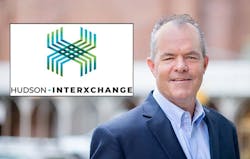With New Brand and Owners, Hudson Interxchange Looks to Grow at 60 Hudson
There’s a new brand in the New York City data center market, but it’s an evolution of an existing player at one of the most familiar addresses in digital infrastructure.
Hudson Interxchange (Hudson IX) is the successor to DataGryd, which was acquired in January by UK-based investor Cordiant Digital Infrastructure. The revamped Hudson IX has a new brand, and will expand its footprint inside 60 Hudson Street, one of the world’s most iconic carrier hotels. Thomas Brown will continue as CEO as the company sharpens its focus on selling colocation and interconnection services, rather than its initial emphasis on wholesale data center space.
Cordiant paid $74 million for the DataGryd assets, and sees the deal as a first step into the U.S. market for interconnection services. “We’re looking at both existing and emerging markets in the U.S. and are also considering expanding north into Canada,” adds Brown. “There are many opportunities for us to grow.”
Cordiant plans to invest at least $75 million in Hudson IX over the next three years, enabling the company to build out substantial expansion capacity within 60 Hudson Street,
With the rebranding, Hudson IX is leading with its location, leveraging the building’s central place in the Manhattan connectivity landscape.
“We’re really excited about the new brand,” said Brown. “We have unique infrastructure that you cannot replicate anywhere. We have pivoted to focus on enterprise retail colocation space for latency-driven applications. We believe we’re adding tremendous value and allowing customers to interconnect seamlessly.”
New Brand to Support an Industry Landmark
60 Hudson Street has been on the front lines of communications since it was completed in 1930. Originally the headquarters for Western Union, the building has been a key transfer point for the world’s information, first with telegrams delivered through pneumatic tubes, and over time rewiring for Trans-Atlantic telephone circuits, and then the Internet.
The carrier hotel at 60 Hudson Street in Manhattan. (Photo: Rich Miller)
Manhattan has a reputation as a mature data center market, with most of its space focused in a handful of connectivity hubs that were established in the late 1990s following the deregulation of the telecom industry. The city’s most prominent “carrier hotels” built upon established intersections for commerce and communications. That includes the AT&T building at 32 Avenue of the Americas, and the former Port Authority building at 111 8th Avenue, which is now owned by Google.
Google’s purchase of 111 8th Avenue altered the competitive landscape, as the company wanted to use the building’s large footprints for office space, not colocation. Around that same time, the New York City Department of Corrections was vacating four floors of office space that it leased at 60 Hudson Street.
Newcomer DataGryd took over the space, with plans to build out 240,000 square feet of data center space on floors 5 through 8 of the 24-story tower. DataGryd worked with the ownership of 60 Hudson to retrofit the landmark building to support additional power capacity. That paid off in 2014 when Telx leased the entire 60,000 square foot 5th floor, which is now controlled by Digital Realty.
In 2019, DataGryd began building out the still vacant 6th floor, creating a 1 megawatt “MegaSuite” data hall on spec.
Initially, DataGryd had four floors leased at 60 Hudson Street. Two of the floors (7 and 8) were options. The options expired, but Cordiant ensured that the options on 7 and 8 were reinstated for future expansion as part of the overall lease transaction for four floors.
Cordiant Sees ‘Compelling Opportunity’
The acquisition by Cordiant provides capital to build out the rest of the sixth floor in additional 1-megawatt suites.
“With Cordiant’s backing, we are ready to move forward with our expansion to four floors of 60 Hudson Street, which will make us the building’s largest single tenant and further position us as a leading player in this critical market segment,” said Brown.
Cordiant Digital Infrastructure is a UK-based investment fund that went public in 2021 on the London Stock Exchange, raising 370 million pounds (about $445 million US) to acquire assets in the data center, fiber and telecom tower industries. Chairman Steven Marshall was had successful tenures in leadership at American Tower and National Grid Wireless, while Benn Mikula had managing director roles in tech research at JPMorgan and RBC Capital.
In June it lined up 200 million Euro in financing for future acquisitions. (We’d tell you more, but access to Cordiant’s website is limited to UK residents). Its other notable acquisitions include Emitel, a mobile operator in Poland which Cordiant bought for $352 million, and Czech telecom firm České Radiokomunikace (CRA) in 2021.
Power and cooling infrastructure supporting the Hudson Interxchange data center on the 6th floor of 60 Hudson Street. (Photo: Hudson IX)
“The DataGryd platform offers our investors a compelling investment opportunity to invest in interconnect datacenters,” said Mikula, Managing Partner and Co-CEO, Cordiant Capital. “This platform can deliver scale, high quality infrastructure, power and technical skill in what we believe is the most connected building in the most connected city globally. These are strategic assets with significant growth potential.”
Looking Beyond Manhattan
Hudson IX enters a challenging market. Although data center leasing has been on the upswing, Manhattan colocation deals are focused on smaller deals of 500 kW or less, with connectivity and interconnection being the key motivation for paying a premium to host gear in the city rather than New Jersey or other suburbs.
The competition is not just providers in other buildings, but other providers at 60 Hudson Street. Both Digital Realty and DataBank operate interconnection businesses within the building.
Hudson IX’s strong suit, both in 60 Hudson and beyond, will be “aggregation points with a concentration of providers that will enable the interconnection platform.”
“Looking to the future, Hudson IX is not stopping at 60 Hudson,” said Brown. “While we will expand operations at 60 Hudson, Hudson IX as a whole will enter strategic alliances within the industry and evolve into a dynamic, customer-facing organization that is part of the broader interconnectivity ecosystem. Right now, there are not enough aggregation points within the data center industry. Seamless interconnection is key. We plan to be a major player in that effort.”






